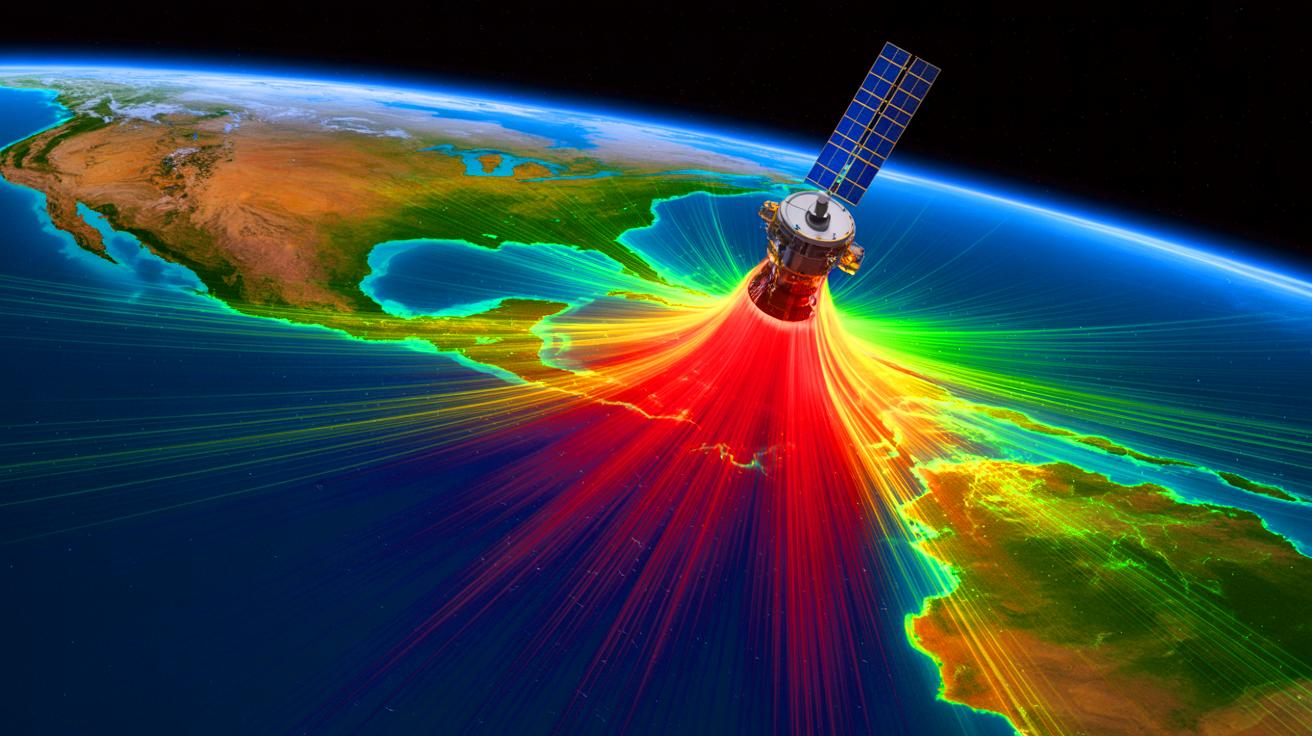IN A NUTSHELL
🌍 The South Atlantic Anomaly (SAA) is a region of weakened magnetic field, posing risks to space technology and satellites.
🛰️ Satellites passing through the SAA face potential single event upsets, which can lead to system malfunctions and data loss.
🔄 The anomaly is dynamically evolving, drifting northwest and splitting into two lobes, creating additional hazards for spacecraft.
🔬 NASA uses satellite data and simulations to model the magnetic field’s evolution, crucial for mission planning and understanding Earth’s dynamics.
The South Atlantic Anomaly (SAA) has become a subject of intense study, drawing attention from scientists and space agencies around the globe. This region, characterized by a unique weakening of Earth’s magnetic field, poses significant challenges, particularly for space technology. The anomaly, situated over South America and the South Atlantic Ocean, is a natural phenomenon with potential consequences for satellites and spacecraft. Understanding the origins and implications of the SAA is crucial as it evolves, demanding innovative solutions to safeguard technological infrastructure and enhance our comprehension of planetary dynamics.
Deep Origins and Complex Mechanisms
The South Atlantic Anomaly (SAA) represents a significant reduction in magnetic intensity, creating a breach in Earth’s protective shield. This allows high-energy solar particles to come perilously close to the planet’s surface. The origins of the SAA are linked to complex processes within Earth’s outer core, known as the geodynamo. Here, the motion of molten iron and nickel generates Earth’s magnetic field, although not uniformly.
Two primary factors contribute to the SAA: the tilt of Earth’s magnetic axis relative to its rotational axis and the influence of a dense structure deep beneath Africa, known as the African Large Low Shear Velocity Province. These elements disrupt magnetic field generation, resulting in a local polarity reversal and a weakened magnetic intensity in this region. This intricate interplay underscores the critical need for ongoing research to unravel the SAA’s mysteries and anticipate its future impact.
A Threat to Space Technology
The SAA poses notable risks to space technology, as satellites passing through the region encounter elevated levels of energetic protons. These particles can cause single event upsets (SEUs), leading to temporary malfunctions, data corruption, or even permanent damage if critical systems are compromised. To mitigate these risks, satellite operators adopt precautionary measures, such as shutting down non-essential systems during SAA transits.
The International Space Station (ISS) also crosses the SAA, exposing its external instruments to potential vulnerabilities. While astronauts are shielded, instruments like the GEDI experience occasional glitches, resulting in data loss. Missions like the Ionospheric Connection Explorer (ICON) closely monitor the SAA, adjusting operations to minimize disruptions. Understanding the SAA’s impact on space technology remains vital for ensuring the reliability and longevity of orbiting infrastructure.
Dynamic Evolution and Challenges
The South Atlantic Anomaly is not static; recent data from ESA’s Swarm constellation and NASA’s SAMPEX mission reveal concerning trends. The anomaly is slowly drifting northwest, expanding in surface area, and beginning to split into two distinct lobes. This bifurcation creates additional hazardous zones for spacecraft, complicating predictive modeling of geomagnetic conditions.
Scientists emphasize the importance of continuous monitoring and adaptation in satellite operations to mitigate potential disruptions. Understanding the evolving nature of the SAA is crucial for safeguarding current and future satellites. As the anomaly changes, it presents challenges that require innovative approaches to ensure the safety and functionality of space missions. The ongoing evolution of the SAA underscores the need for vigilance and adaptability in the face of dynamic geomagnetic phenomena.
Anticipating the Invisible
NASA leverages satellite data and core simulations to enhance its understanding of the SAA and refine predictive models. These models, such as the International Geomagnetic Reference Field (IGRF), track Earth’s magnetic field evolution. They are essential for space mission planning and offer insights into Earth’s internal structure.
Although the current SAA is unprecedented in the space era, geological records suggest that such anomalies are not uncommon over long timescales. Importantly, the SAA is not an indicator of an impending magnetic pole reversal, a rare event occurring over hundreds of thousands of years. Studying the SAA remains a vital research area, essential for protecting orbiting technologies and deepening our understanding of Earth’s magnetic dynamics. As the SAA continues to evolve, it poses intriguing questions about the future of our planet’s magnetic behavior.
As the South Atlantic Anomaly evolves, scientists and space agencies remain vigilant in their efforts to understand and mitigate its impact. The anomaly’s potential to disrupt satellite operations and influence our understanding of Earth’s magnetic field raises intriguing questions about the future of planetary dynamics. How will these changes shape our technological and scientific endeavors in the coming years?
This article is based on verified sources and supported by editorial technologies.
Did you like it? 4.4/5 (22)

